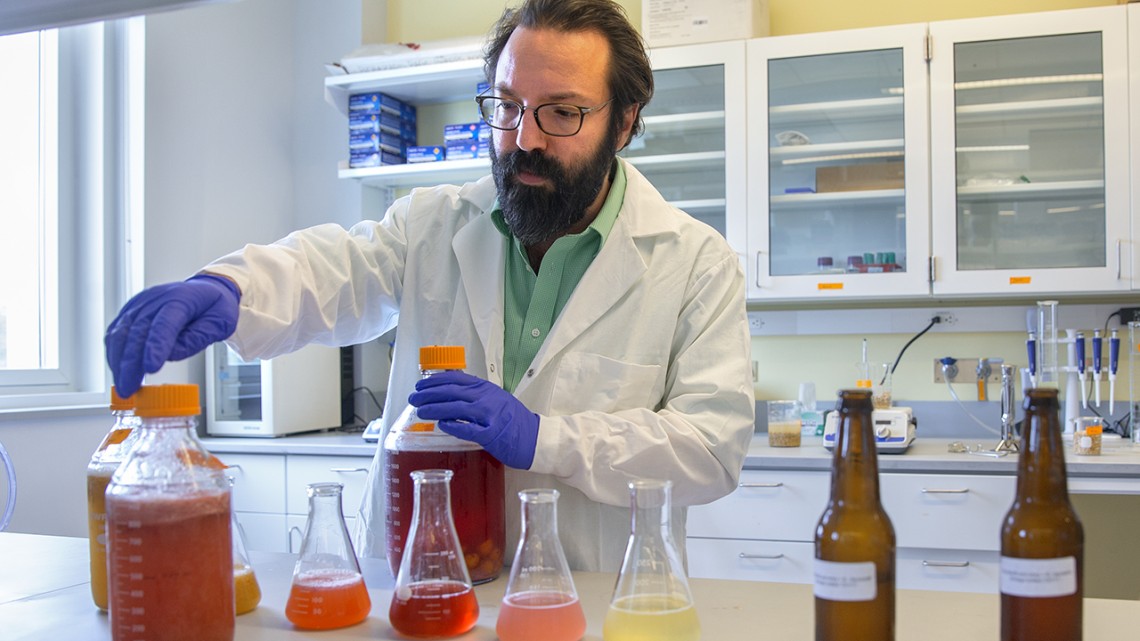Remote, part-time Fellowships available for graduate students from diverse backgrounds to learn about and contribute to ongoing food and beverage sector research projects.
Tag: Food Safety
Collaborative Research Institute Offers March 3, March 24 Webinars on Gut Microbiome
Research on the relationship between the gut microbiome and diet can provide insights into diseases like depression and other health conditions.

Some food contamination starts in the soil
Rice husk residue can prevent uptake of harmful elements in rice
NEW RESEARCH: MONITORING ONLINE POSTS BY CONSUMERS COULD HELP IMPROVE FOOD SAFETY
An estimated 48 million cases of foodborne illness are contracted in the U.S. annually, causing about 128,000 hospitalizations and 3,000 deaths, according to CDC. In some instances, the source is well known, but 80 percent of food poisoning cases are of unknown origin. A new study published by Risk Analysis, proposes a new Food Safety Monitoring System that utilizes data mining on websites to identify products associated with food-related illnesses.
Groups Denounce Misleading “One Health CertifiedTM” Label Scheme
Today, a coalition of animal welfare, consumer, public health, and environmental organizations called on grocery stores, restaurants and meat producers to reject the use of a misleading label scheme known as One Health CertifiedTM (OHC) and the standards behind it. The label was approved for use on chicken and turkey products earlier this year and is now being used by a handful of grocery store chains, including Aldi and BJ’s, and at least one restaurant chain. Consumer Reports recently assigned the OHC label its second poorest rating because the standards behind the label essentially reflect current problematic industry practices related to antibiotic use, animal production, and environmental impact.
Food scientists mentor international COVID-19 task force
Food businesses and consumers coping with COVID-19 impacts in five countries in Asia and Africa now have access to customized resources, and experts mentored by the Institute for Food Safety at Cornell University.

Tackling food allergies at the source
Food allergies cost billions of dollars and cause enormous suffering for people. Researchers are trying to remove the source of food allergies altogether — troublesome proteins made by our favorite crops.
Food safety lab grants $2.9M for new global projects
The Feed the Future Innovation Lab for Food Safety, co-located at Cornell and Purdue Universities, has announced $2.9 million in grants for research projects to improve food safety and prevent foodborne illness in Bangladesh, Cambodia, Kenya and Senegal.
Scientists to improve food plant worker safety, product supply
A Cornell University-led project will use computer modeling and outreach to find optimal strategies to minimize COVID-19 cases and transmission among workers in food processing facilities, while maintaining the best possible production.
Rutgers Expert Available to Discuss Risk Perception in COVID-19 Era
New Brunswick, N.J. (Oct. 26, 2020) – Rutgers University–New Brunswick Professor William Hallman is available for interviews on the science of risk perception and its practical implications in the COVID-19 era – a time of fear and anxiety among millions of…
Translating soil chemistry science to improve human health
Contaminated soils – and foods – influenced by soil factors
Shipping holiday food: How to properly prepare, package, send
During the COVID-19 pandemic, people have not been able to visit family and friends as they normally do, so this holiday season sending traditional homemade specialties and foods can be especially meaningful. It’s important to keep food safety in mind…

Reducing cadmium levels in cacao
Researchers are working to help cacao farmers manage harmful cadmium levels in the soil.
CDC E. coli report shows effective detection systems, low health risks
A study in the journal Emerging Infectious Diseases published by Centers for Disease Control and Prevention on Wednesday examines E. coli outbreaks linked to leafy greens in the United States and Canada from 2009 to 2018. Professors of food safety at Cornell…
A new method may make tomatoes safer to eat
When vegetable farmers harvest crops, they often rely on postharvest washing to reduce any foodborne pathogens, but a new University of Georgia study shows promise in reducing these pathogens – as well as lowering labor costs— by applying sanitizers to produce while it is still in the fields.
USDA Says Current Poultry Food Safety Guidelines Do Not Stop Salmonella Outbreaks
Current poultry food safety guidelines for Salmonella, the leading cause of foodborne illness outbreaks, are inadequate. A new study conducted by Thomas Oscar, USDA Agricultural Research Service, “Salmonella prevalence alone is not a good indicator of poultry food safety,” published in Risk Analysis, explores additional factors that must be considered in order to identify poultry products that are truly safe for human consumption.
Webinar Series on the Gut-Brain Axis and the Microbiome
There is currently much interest in the gastrointestinal microbiota and its modulation as it relates to implications for host health. A notable aspect is the bidirectional communication between the gut microbiota and brain, referred to as the gut-brain-axis. Nutritional interventions have powerful effects on the gut microbiota but another significant and often overlooked factor is the influence of physical activity.

McMaster and Toyota Tsusho Canada, Inc. collaborate to move pathogen-detecting food wrap from lab to market
Toyota Tsusho Canada, Inc. (“TTCI”) will team up with McMaster engineers and biochemists to move a promising new food-safety technology from the lab to the marketplace.

Food safety investments open new markets, boost revenue for small farmers
A new Cornell University study finds that when small-scale farmers are trained in food safety protocols and develop a farm food safety plan, new markets open up to them, leading to an overall gain in revenue.

Researchers print, tune graphene sensors to monitor food freshness, safety
Researchers are using high-resolution printing technology and the unique properties of graphene to make low-cost biosensors to monitor food safety and livestock health.

Reusing chicken litter shows benefits
Beneficial bacteria in reused poultry litter can reduce Salmonella levels
Researchers Identify Seasonal Peaks for Foodborne Infections
Using a newly developed approach, researchers have identified seasonal peaks for foodborne infections that could be used to optimize the timing and location of food inspections.
FOOD EXPERT OFFERS MEAL PLANNING, GROCERY SHOPPING TIPS DURING COVID-19
The Academy of Nutrition and Dietetics offers tips for planning, preparing and storing healthful meals while under quarantine during the novel coronavirus COVID-19 pandemic.
Food Safety and Coronavirus
Covid Conversations on Risk featuring Jade Mitchell, Ph.D., and Felicia Wu, Ph.D. both from Michigan State University addresses food safety and risk. A recording of the webinar can be found on the SRA website at https://sra.org/covid-19-resources

WVU Extension Service expert offers tips for a safe, healthy farmers market season
As farmers markets across the country open for the season, West Virginia University Extension Service Agribusiness Economics Specialist Dee Singh-Knights provides a few recommendations to help market managers and vendors safely sell their products to customers and allow communities to…
Rutgers Food Innovation Center Offers Virtual Food Safety Training
New Brunswick, N.J. (April 13, 2020) – Food safety certificate courses offered by Rutgers’ Food Innovation Center are now available via interactive virtual training, including face-to-face video conferencing. Specialty food industry manufacturers, retailers, distributors and individuals across the food supply…

Expert Pitch: WVU Extension Service offers food safety tips
Although food recommendations have not changed due to COVID-19, there are a few important items to remember when storing food after a trip to the grocery store. To help us understand more about ways to keep our food safe, West…

Food safety expert: takeout is a low-risk option
Takeout is a good choice to lower risk of exposure because it reduces the number of touch points relative to eating in a restaurant, said food safety expert.

Cornell creates detailed COVID-19 website for food industry
To keep New York’s food processing industry safe during the COVID-19 pandemic, Cornell University’s Institute for Food Safety has created a comprehensive, practical and convenient website for commercial processors.

Some good news: Livestock and poultry appear to be safe from COVID-19
AMES, Iowa – Veterinarian and food safety expert Jim Roth is available for interviews regarding the potential impact of COVID-19 on food safety. Iowa State has a live studio available, though it may require some extra time to arrange an…
Tips for proper leftover food safety techniques
If you are doing more cooking than usual due to coronavirus-related concerns, it’s important to make sure leftovers are stored properly.

Food scientists slice time off salmonella identification process
Researchers from Cornell and the Mars Global Food Safety Center can complete whole-genome sequencing to determine salmonella serotypes in two hours and the whole identification process within eight hours.

CCE educators help farmers meet new produce safety codes
Trained Cornell Cooperative Extension agents teamed with New York State Department of Agriculture and Markets personnel across the state to offer free and confidential on-farm readiness reviews to insure that farmers can meet new produce safety standards.

Power of photojournalism seen in early 20th century exposé on Chicago meat industry
A 1905 story not only prompted massive reforms in U.S. food and public health policy and inspired Upton Sinclair’s widely popular novel “The Jungle.” It was also one of the first examples of the power of photojournalism, as uncovered in a recent Iowa State University study.

Hundreds of Environmental Health Professionals Across the Country Report Challenges and Research Needs
Hundreds of environmental health professionals across the nation report challenges and research needs in six areas — drinking water quality, wastewater management, healthy homes, food safety, public health pests and emerging issues such as disaster risk reduction and new facility types for body art and cannabis-infused products — in research from Baylor University and national health partners.
Study suggests French ban on food additive may be premature
Michigan State University and University of Nebraska Medical Center researchers are refuting an earlier French government-funded study that claims titanium dioxide, a common food additive used worldwide, causes digestive inflammation and lesions in rats.